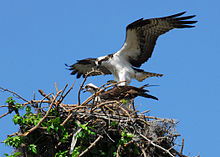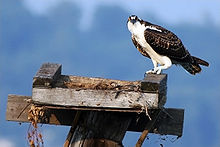A familiar sight has returned to the lower Deschutes river this past week and it’s a sign of the changing season. Every spring migrating Osprey return to their nests perched high above the river to mate and rear their young, they are just one of the many animals that call the Deschutes river canyon their home for the season. And now that the Osprey have returned the river seems even more abuzz with activity.
The Osprey mate for life and return to the same nest year after year and are very territorial. They are birds of prey in the raptor family and are sometimes referred to as a sea hawk, fish eagle, or river hawk and can be found on every continent except Antarctica. Osprey are born fish hunters and they have specialized features like a reversible outer toe that makes it easier to hold on to slippery prey like fish. Their eyesight is adapted to allow for better vision searching for fish in the waters below often from heights as high as 100 feet or more. The Osprey weighs in around 2 to 4 and a half pounds and can grow to more than 2 feet tall and have a wingspan almost six feet wide! The shape of their wings allow them to hover in place momentarily just before they plunge feet first into the river grasping food with tarsi that reticulate ensuring that they don’t lose their freshly caught dinner.
On our signature Deschutes raft trip it’s not that uncommon to witness an Osprey circling high above your head excitedly chirping just before it dive bombs into the river with a big splash and then takes flight again with a trophy redside trout taunting one of the nearby fishermen with it’s prize catch.
Over a hundred years ago the two railroad companies that built track along the Deschutes river cut down practically every tree that grew along or near the river to build their rail lines devastating the Osprey’s natural habitat. And, when the Osprey began to rebuild their nests in the newly erected power lines along the tracks they were shot on sight as a nuisance further decimating their numbers.
Today, between the put in at Harpham Flats to the take out at Sandy Beach there are more than half a dozen man made nesting platforms that have been erected to ensure that the Osprey have adequate places to build their nests and their numbers have come back exponentially and now they thrive once again soaring high above the river. When you see the same birds return year after year and watch them raise their young from hatchlings to witnessing their first flight you can’t help but feel like an old friend has come home to roost.





